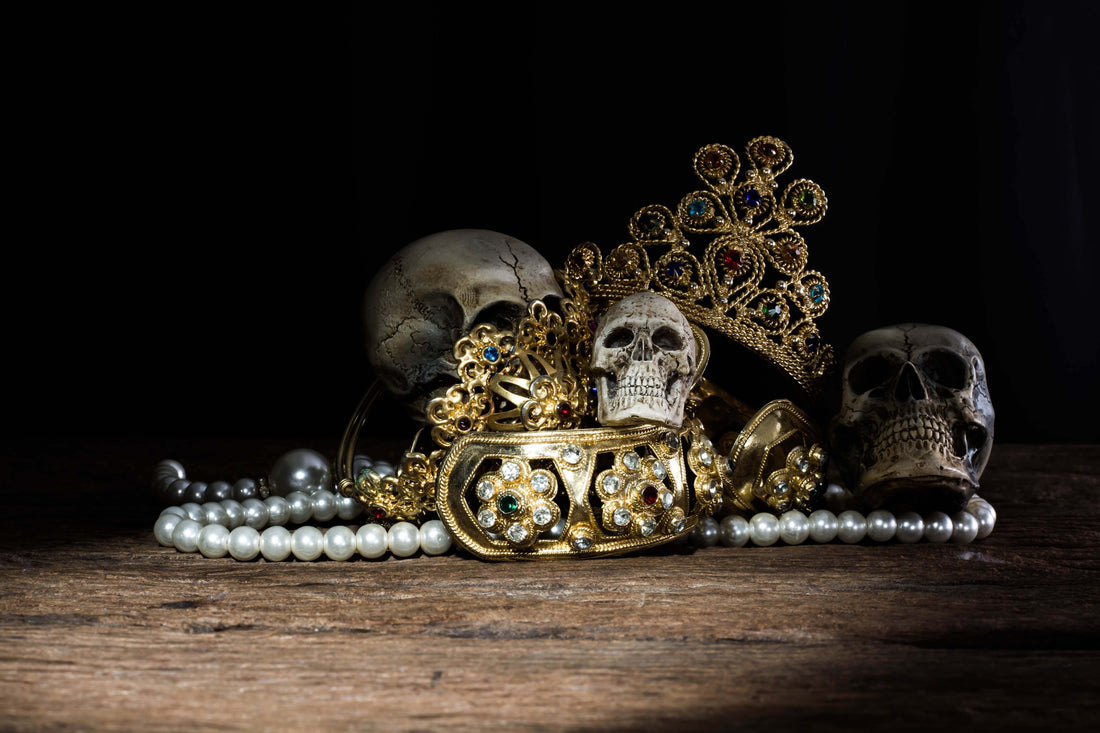
Wear At Your Own Risk – Cursed Gemstones Throughout History Part 1
“Whoever shall then open it, shall first read out this warning, and then do as he pleases with the jewel. My advice to him or her is to cast it into the sea.”

Delhi Purple Sapphire
by Sarah-Rose, CC BY-ND 2.0
Delhi Purple Sapphire
When Peter Tandy opened a sealed box inside the London Museum of Natural History’s mineral cabinets, he found this message. Along with the message was the Delhi Purple Sapphire, a stone that had left a sea of destruction after being removed from the Indian Temple of Indra in 1857. Stolen from a temple that honored the Hindu god of war during a bloody mutiny, the gem is said to carry a curse that befalls misfortune on whoever possesses it.
Its victims include English Colonel W. Ferris, who brought the stone to England and later went bankrupt, along with his son, who inherited it after his death. Writer Edward Heron-Allen then purchased it. After months of misfortune, the writer gifted it to a friend, a singer who permanently lost her singing voice while possessing the stone and who returned it. Heron-Allen threw the gem into the Regent Canal, only for it to be found and returned to him months later.
He eventually locked it up with the family banker to be donated after his death, with explicit instructions that his daughter must never touch or wear it. Today’s scholars believe that Heron-Allen may have fabricated much of the jewel’s legend to give plausibility to a short story he wrote in 1921 called “The Purple Sapphire.” Legend or not, it isn’t the only cursed gemstone to wreak havoc through history.
 The Hope Diamond
The Hope Diamond
Jyothis at Malayalam Wikipedia, CC BY-SA 3.0, via Wikimedia Commons
The Hope Diamond
Few gemstones in the world are as famous—or as infamous- as the Hope Diamond. This striking deep-blue gem, weighing 45.52 carats, has captured imaginations for centuries with its unmatched beauty, extraordinary provenance, and chilling reputation. Its history begins in 17th-century India, likely unearthed from the famed Kollur Mine in the Golconda region, a source of many legendary diamonds. According to one enduring legend, the original stone—much larger than it is today—was plucked from the eye of a sacred Hindu idol, invoking a curse that would bring misfortune and tragedy to all who possessed it.

Jean-Baptiste Tavernier, 1712.
Nicholas de Largillière, CC0, via Wikimedia Commons
The diamond first appeared in Western records when French gem merchant Jean-Baptiste Tavernier acquired it and brought it to Europe. He sold it to King Louis XIV in 1668, and the stone was recut into what became known as the “French Blue.” It remained part of the French Crown Jewels until the tumult of the French Revolution, when it was stolen during a raid in 1792. Both King Louis XVI and Queen Marie Antoinette—owners of the diamond—were executed shortly afterward, adding fuel to the legend of the gem’s dark influence.
After vanishing for decades, the diamond reappeared in London in the early 19th century, recut into its current form, and acquired by British collector Henry Philip Hope. Over the next century, it passed through several private hands, with many of the owners experiencing financial ruin, madness, or premature death. By the early 20th century, its sinister reputation was well established, and stories of the Hope Diamond’s curse were widely reported in newspapers and society columns.

Evalyn Walsh McLean wearing the Hope Diamond.
Harris & Ewing, Public domain, via Wikimedia Commons
One of its most famous—and flamboyant—owners was American heiress Evalyn Walsh McLean, who acquired the gem in 1912. A high-society figure with a flair for extravagance, Evalyn reportedly believed that misfortune could be turned to good luck and wore the diamond often: at parties, to the races, even affixed to her dog’s collar. But tragedy followed her nonetheless. Her young son was struck and killed by a car, her daughter died of an overdose, her husband left her for another woman and later died in an asylum, and the family fortune dwindled. Still, Evalyn dismissed the curse publicly, viewing the diamond as her talisman rather than her tormentor. As she wrote in her memoir, Father Struck It Rich, “I know better and yet, knowing better, I believe… I have come to feel—not think—that I have developed immunity to its evil.”
After Evalyn died in 1947, her estate sold the diamond to pay off debts. New York jeweler Harry Winston purchased it and later donated it to the Smithsonian Institution in 1958. Since then, the Hope Diamond has remained on public display, seemingly free from further misfortune, and admired by millions of visitors yearly.

Koh-i-Noor Diamond
Koh-i-Noor Diamond
Koh-i-Noor, or “Mountain of Light,” is another diamond with a bloody history, being passed from ruler to ruler after its extraction from an Indian mine around the year 1100. It is said to carry a curse threatening the throne and life of any man who dares to wear it. Its first known victim was the Mughal emperor Babur, exiled from his kingdom. From there, it decimated the lives of Mughal ruler Shah Jahan, who built the Taj Mahal and was later imprisoned by his son, Mughal conqueror Nadir Shah, who was assassinated, and a line of Persian successors, each of whom was dethroned and ritually blinded.

Painting of Maharaja Sher Singh wearing the Koh-i-Noor diamond.
Ágoston Schoefft, Public domain, via Wikimedia Commons
Koh-i-Noor eventually reached England in the 1850s and was set into a tiara. It remains among the British crown jewels, making Queen Elizabeth II the longest-known possessor and giving credence to the old claim that “only God or a woman can wear it with impunity.”

Imperial State Crown with Koh-i-Noor.
Cyril James Humphries Davenport, Public domain, via Wikimedia Commons
If you’re sensing a theme here, you’re not the only one – “When the powerful take things from the less powerful, the powerless don’t have much to do but curse [them],” notes Richard Kurin, scholar for the Smithsonian. History has proved, however, that curses be damned – there will always be those who shun superstition and covet beautiful (and, more importantly, valuable) gems. What will become of them, unseen forces will decide…
Don’t forget to read the other parts of the Cursed Series for more intriguing stories about these legendary gemstones and jewelry.
